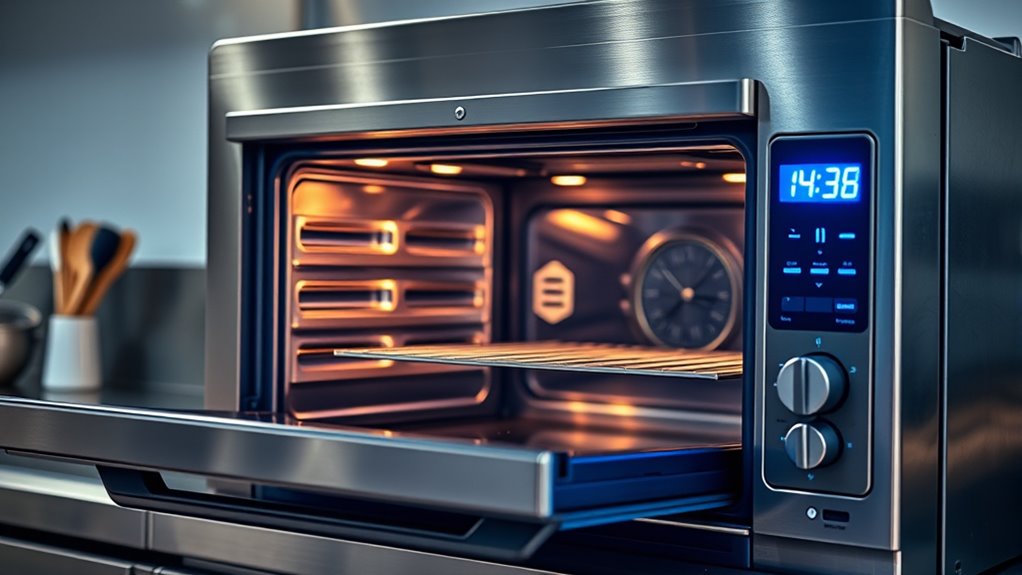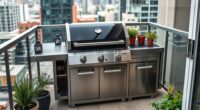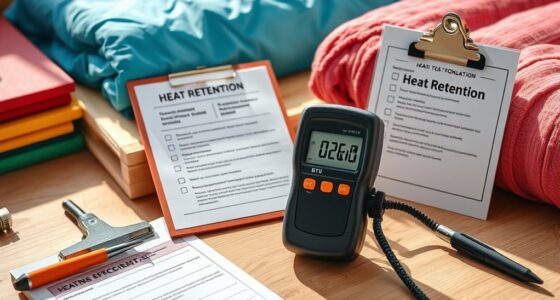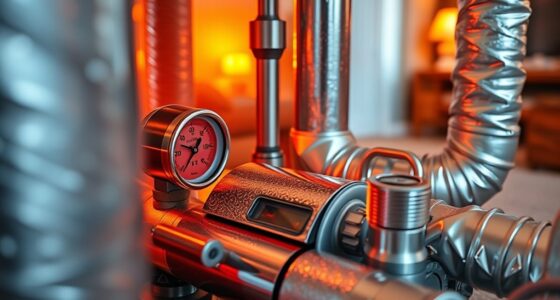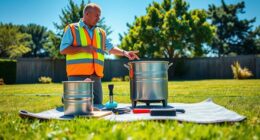Many believe preheating takes longer than necessary or that the oven’s display signals when it’s ready. In reality, your oven is ready once it hits the target temperature, not when the display turns off. Factors like insulation, heating elements, and oven features influence preheat time. Proper calibration and monitoring with an oven thermometer can save energy and improve results. Keep exploring to discover the key truths behind faster, smarter preheating.
Key Takeaways
- An oven is ready once it reaches and maintains the target temperature, not when the display signals preheat completion.
- Preheat duration varies based on oven insulation, heating element strength, and size, not just preset time or signals.
- Using an oven thermometer ensures accurate temperature readings, preventing over-preheating and energy waste.
- Proper calibration and maintenance of oven seals are crucial for consistent heat and optimal preheating efficiency.
- Myth: waiting for preheat signals saves time; fact: monitoring actual temperature yields better baking results.
Common Misconceptions About Oven Preheating

Many people believe that oven preheating should be done for as long as the oven’s display indicates, but this isn’t always necessary. This is a common preheat myth that can lead to wasted energy and time. The temperature truths show that once the oven reaches the target temperature, it’s ready for baking. You don’t need to wait for the display to turn off or for a specific “preheat complete” signal. Relying solely on the display can cause over-preheating, which may affect your baked goods. Instead, focus on knowing when the oven hits the right temperature and use an oven thermometer for accuracy. Understanding these preheat myths helps you save time and energy while ensuring your oven is properly prepared for baking. Additionally, familiarizing yourself with the oven’s temperature accuracy can help prevent unnecessary preheating times and improve baking results.
The Science Behind Proper Oven Temperatures

Understanding the science behind proper oven temperatures is essential for consistent baking results. When you set your oven, the goal is to achieve stable oven heat, which ensures your baked goods cook evenly. Temperature stability depends on how well the oven maintains the set temperature without fluctuations. If the oven heat is inconsistent, your baked items may undercook, overcook, or develop uneven textures. Modern ovens use thermostats to regulate temperature, but factors like door openings or preheating time can impact stability. Knowing how your oven responds to these variables helps you optimize preheating and maintain the right heat level. Additionally, awareness of oven behavior can help you troubleshoot temperature fluctuations and improve baking consistency. Ultimately, precise temperature control allows you to produce reliable, professional-quality baked goods every time.
How Oven Features Influence Preheating Time

Oven features such as heating elements, insulation, and fan systems directly impact how quickly your oven reaches the desired temperature. High-quality oven insulation minimizes heat loss, allowing the oven to heat faster and maintain consistent temperatures. The strength and placement of the heating element determine how quickly heat is generated and distributed. Fan systems, like convection fans, promote even heat circulation, reducing preheating time. The table below highlights key features influencing preheating:
| Feature | Effect on Preheat Time |
|---|---|
| Oven Insulation | Reduces heat loss, speeds up preheat |
| Heating Element | Determines heat generation rate |
| Fan System | Ensures even heat distribution |
| Oven Size | Larger ovens take longer to preheat |
| Thermostat Quality | Affects temperature accuracy and stability |
Optimizing these features helps you save time and ensures better cooking results. Additionally, understanding oven preheat timing can help you plan your cooking process more efficiently.
Practical Tips for Effective Preheating
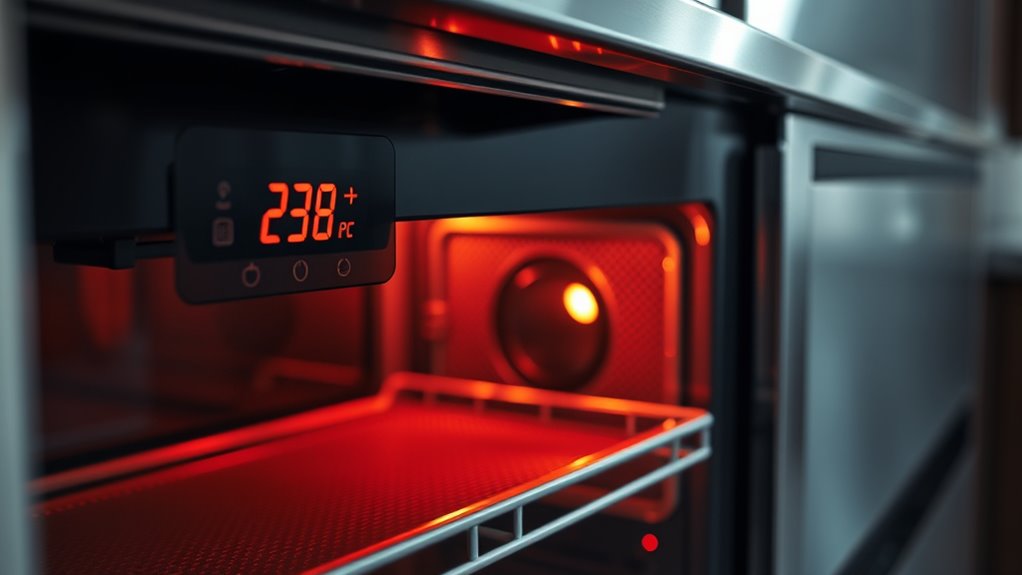
To make the most of your oven’s features and guarantee it heats efficiently, applying practical preheating strategies can make a noticeable difference. First, ensure your oven is properly calibrated; an inaccurate temperature can lead to under- or over-preheating. Use an oven thermometer to verify the temperature matches the setting, and adjust if needed. When preheating, place baking parchment on your baking sheets before loading your food; this ensures even heat transfer and prevents sticking, saving time and effort. Always give your oven enough time to reach the desired temperature before baking—rushing this step can compromise results. Additionally, understanding Gold IRA rollovers can help diversify your retirement savings to ensure long-term financial security. By maintaining accurate calibration and preparing with baking parchment, you’ll achieve more consistent, reliable baking outcomes and maximize your oven’s efficiency during preheating.
When to Adjust Your Preheat Routine for Best Results
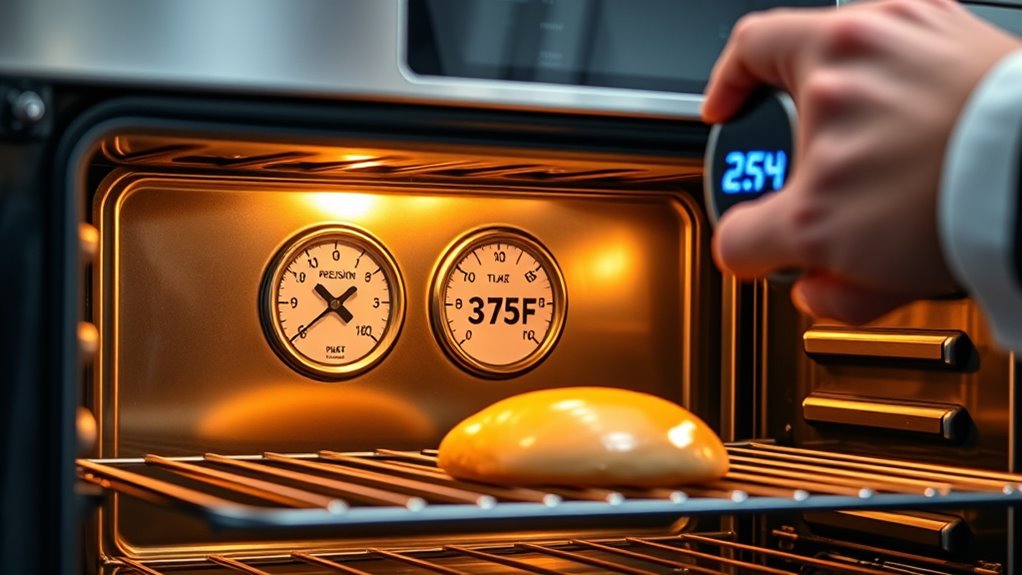
You should consider adjusting your preheat routine whenever you notice inconsistencies in your baked results or if your oven’s performance changes over time. Temperature calibration can drift, causing your oven to heat unevenly or inaccurately, which impacts your preheat timing. Check your oven’s calibration regularly and recalibrate if needed. Additionally, ensure your oven door sealing is intact; a loose or damaged seal can cause heat loss, preventing the oven from reaching the desired temperature efficiently. If your baked goods are undercooked or overcooked despite following your usual preheat routine, these signals suggest it’s time to reassess. Proper oven maintenance and calibration are crucial to maintaining accurate temperature control, and adjusting your preheat process based on these factors guarantees more precise temperature control, helping you achieve consistent, professional results every time.
Frequently Asked Questions
How Does Oven Insulation Affect Preheating Efficiency?
Oven insulation plays a key role in preheating efficiency by improving heat retention. When your oven has good insulation, it traps heat better, reducing the time needed to reach the desired temperature. This means less energy is wasted, and preheating becomes quicker. Poor insulation allows heat to escape, making your oven take longer to preheat and consume more energy. Ensuring proper insulation boosts overall efficiency and saves you time and energy.
Can Using Different Cookware Change Preheat Times?
Using different cookware material can definitely modify your preheat times and affect preheat consistency. For example, metal pans heat up faster than glass or ceramic ones, so your oven reaches the desired temperature quicker when using metal. Non-stick coatings may also influence heat transfer. Keep in mind, choosing the right cookware material helps you maintain consistent preheat times and ensures your cooking starts accurately every time.
What Role Does Oven Door Material Play in Preheating?
Did you know that oven door material substantially impacts heat retention? Your door’s material, like glass or metal, influences how well the oven maintains temperature during preheat. A metal door, for example, retains heat better than glass, leading to quicker preheating times. Choosing the right door material guarantees your oven heats efficiently, saving you time and energy. So, consider your oven’s door material when aiming for ideal preheat performance.
How Do Ambient Kitchen Temperatures Impact Preheating?
Ambient kitchen temperatures can affect your preheating process by influencing how quickly your oven reaches the desired temperature. Higher humidity may slow heat transfer, while cooler air can extend preheat time. Additionally, ambient noise levels won’t impact preheat directly but might distract you from monitoring the oven. To verify accurate preheating, keep an eye on your oven’s thermometer and consider the kitchen’s overall temperature and humidity for best results.
Is Preheating Necessary for All Types of Baked Goods?
Surprisingly, you don’t always need to preheat for every baked good. While preheating improves safety and ensures even baking, some recipes like casseroles or bread don’t demand it. Skipping preheat can save energy, but for delicate pastries or cakes, it’s vital for consistent results. So, assess your recipe’s needs; sometimes, preheating is essential, and other times, it’s just a waste of oven energy.
Conclusion
So, now that you know the truth about preheating, go ahead and ditch those old myths. Don’t waste time waiting for the oven to hit “perfect” temp—just trust science, your oven’s features, and maybe your gut. After all, who needs precision when you can just toss in your dish and hope for the best? Happy baking! Or burning, if you ignore these tips—your call.
